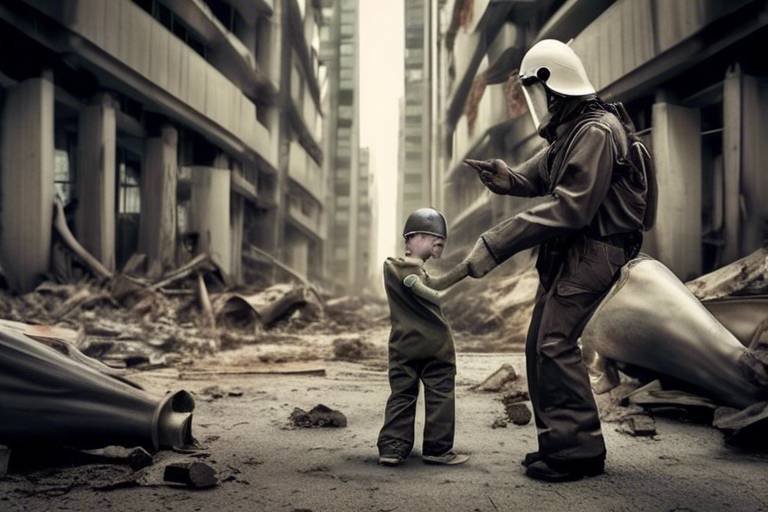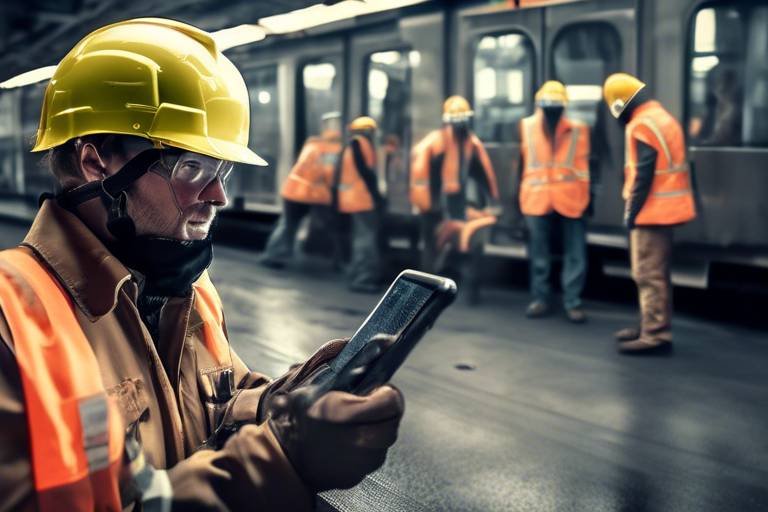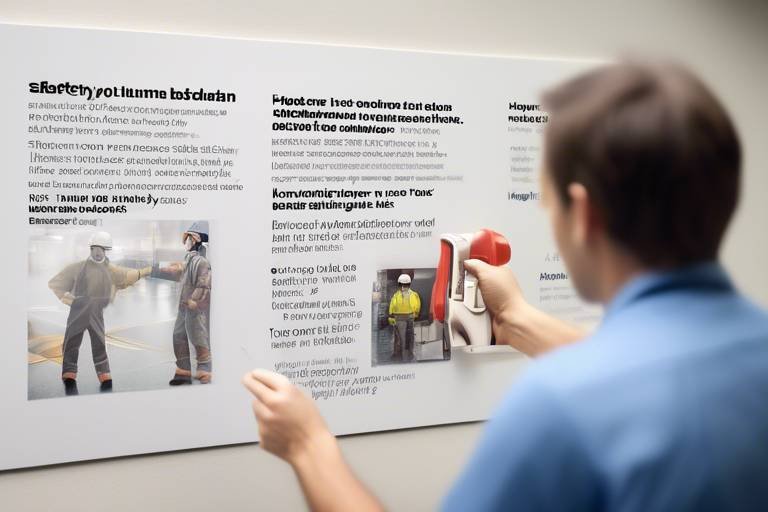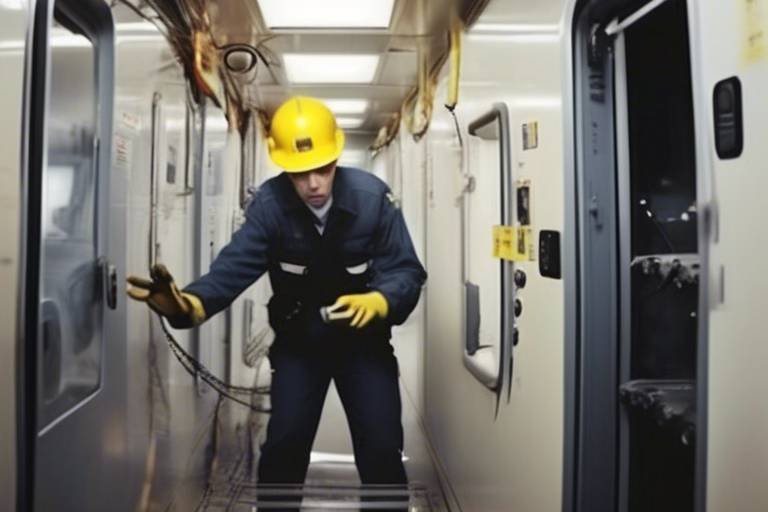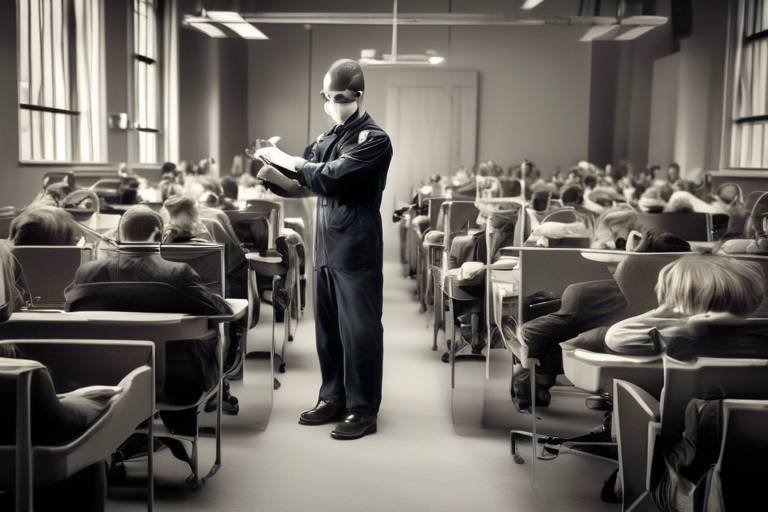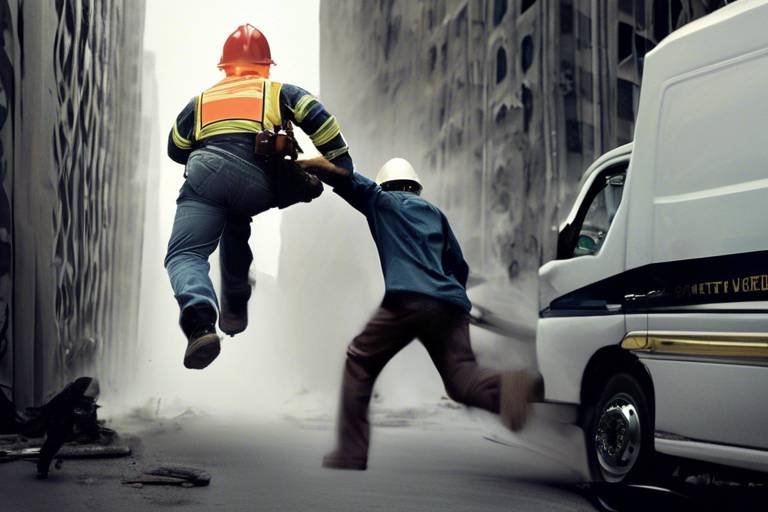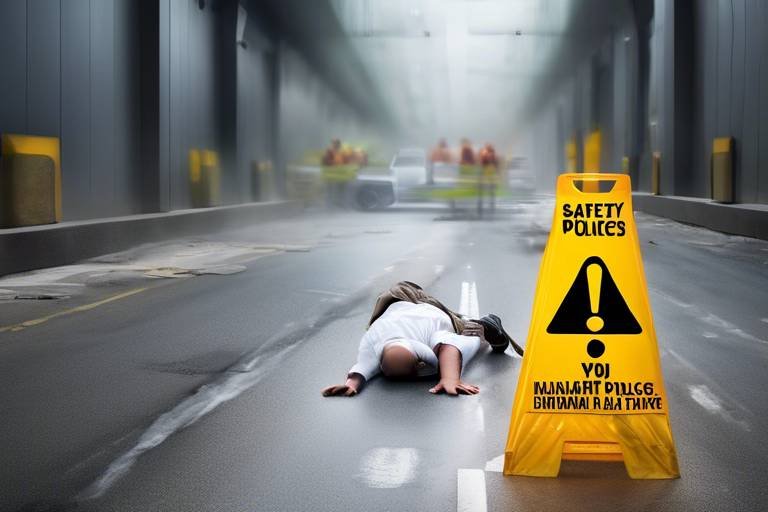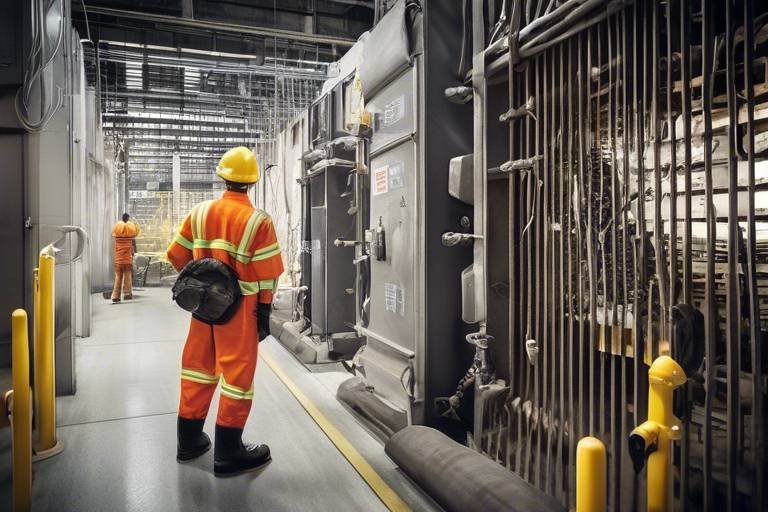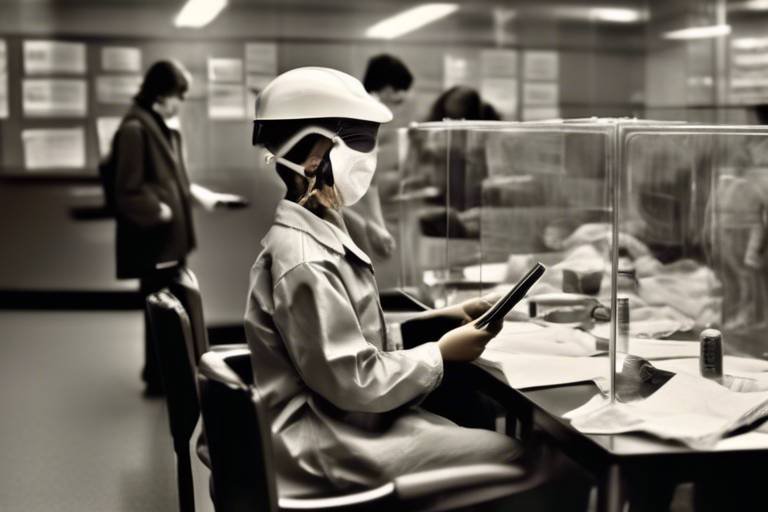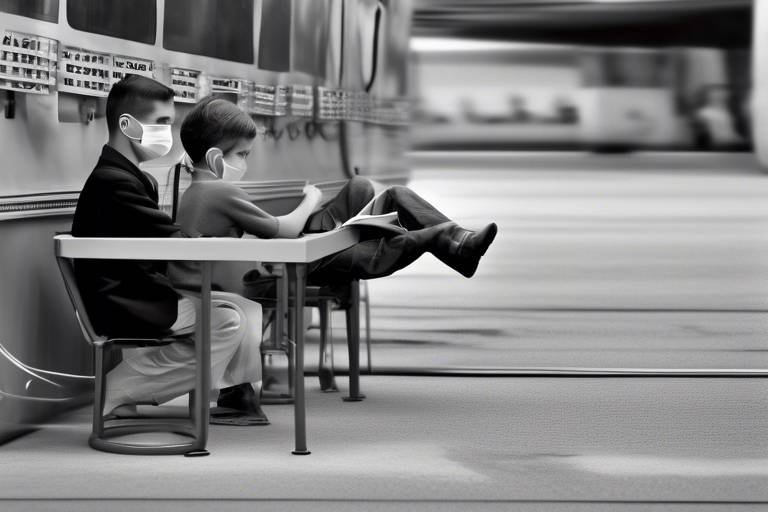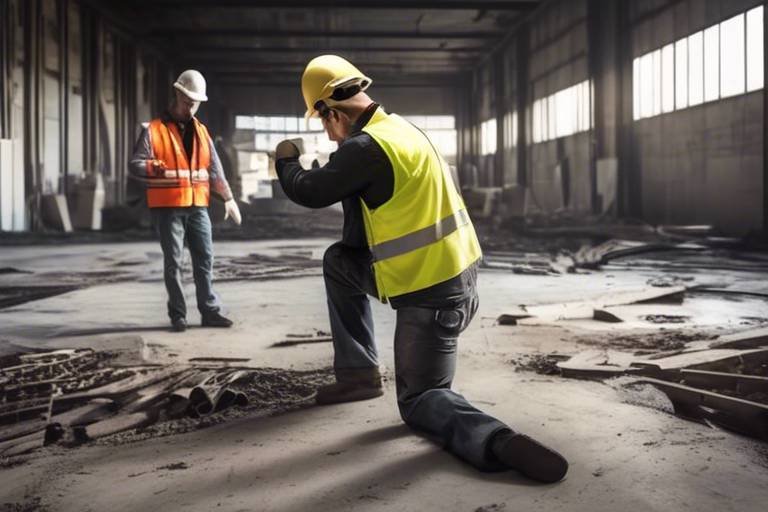Human Behavior as a Safety Determinant
When we think about safety, it’s easy to focus solely on the physical aspects—like equipment, protocols, and regulations. However, the truth is that human behavior plays a pivotal role in determining safety outcomes across various environments. Whether in a workplace, at home, or in public spaces, how individuals react to potential hazards can significantly influence their well-being and that of others around them. By understanding the intricate web of psychological, social, and environmental factors that drive these behaviors, we can develop strategies that not only enhance safety but also foster a culture of care and responsibility.
Imagine a construction site bustling with activity. Workers are operating heavy machinery, and safety signs are prominently displayed. Yet, amidst this controlled chaos, a worker decides to skip wearing a helmet because “everyone else is doing it.” This scenario highlights a fundamental truth: even the most stringent safety measures can fall short if individuals do not prioritize their own safety or that of their peers. This article delves into the various elements that contribute to human behavior as a safety determinant, emphasizing the need for a holistic approach to safety that encompasses not just rules, but also the people who follow them.
At its core, human behavior in safety contexts is influenced by a myriad of factors. For instance, psychological elements such as perception of risk and personal attitudes toward safety can greatly affect how one responds in hazardous situations. Additionally, social influences—like peer dynamics and leadership—can either encourage safe practices or lead individuals to engage in risky behaviors. Finally, environmental factors, including workplace design and the integration of technology, play a crucial role in shaping safety behaviors. By examining these facets, we can better understand how to promote safer practices and ultimately create environments where safety is a shared responsibility.
In the following sections, we will explore the psychology behind safety behaviors, the impact of social influences, and the environmental conditions that affect how we act in potentially dangerous situations. Through this exploration, we aim to uncover insights that can help organizations and individuals alike cultivate a culture of safety that is proactive rather than reactive. Because when it comes to safety, it’s not just about following rules; it’s about fostering a mindset that values well-being above all.

The Psychology of Safety Behavior
Understanding the psychological factors that drive safety behaviors is essential for organizations aiming to foster a culture of safety. It's fascinating how our minds work when faced with potentially hazardous situations. Have you ever wondered why some people take risks while others play it safe? The answer lies in a complex interplay of cognitive processes, emotions, and past experiences that shape our choices. For instance, an individual’s perception of risk can be influenced by their previous encounters with danger, their level of training, and even their emotional state at the moment.
One of the key psychological concepts at play is risk perception. This refers to how individuals assess the likelihood and severity of a potential hazard. Some people may underestimate risks, believing that "it won't happen to me," while others may overestimate them, leading to unnecessary anxiety. This discrepancy can significantly affect safety behavior. Organizations can benefit from understanding these perceptions and addressing them through effective communication and education.
Another critical aspect is motivation. What drives individuals to adhere to safety protocols? Is it intrinsic motivation—like a personal commitment to safety—or extrinsic factors, such as the fear of punishment or the desire for approval from peers? Research shows that when individuals feel personally responsible for their safety and the safety of others, they are more likely to engage in safe behaviors. Organizations can enhance this sense of responsibility by fostering a supportive environment where safety is prioritized and recognized.
Moreover, mental models play a significant role in shaping safety behavior. These are internal representations of how things work based on our experiences and knowledge. For example, if a worker has a mental model that associates wearing protective gear with safety, they are more likely to use it consistently. Conversely, if their mental model lacks this association, they may neglect safety measures. Training programs should aim to align these mental models with the organization's safety standards, ensuring that employees understand the importance of their actions in maintaining a safe environment.
To sum it up, the psychology of safety behavior is a multifaceted area that encompasses risk perception, motivation, and mental models. By understanding these factors, organizations can develop targeted strategies that promote safer practices among their employees. This not only enhances individual safety but also contributes to a collective culture of safety that benefits everyone involved.
| Psychological Factors | Impact on Safety Behavior |
|---|---|
| Risk Perception | Affects how individuals assess and respond to hazards |
| Motivation | Drives adherence to safety protocols |
| Mental Models | Shapes understanding and implementation of safety measures |
In conclusion, recognizing the psychological underpinnings of safety behavior allows organizations to tailor their safety programs more effectively. By addressing the cognitive and emotional drivers behind safety practices, they can create an environment where safety becomes a shared value, rather than just a set of rules to follow.
- What is risk perception, and why is it important?
Risk perception refers to how individuals evaluate the likelihood and severity of hazards. It's crucial because it influences their behavior in potentially dangerous situations. - How can organizations improve motivation for safety?
Organizations can improve motivation by fostering a culture of safety that recognizes individual contributions and emphasizes personal responsibility. - What role do mental models play in safety behavior?
Mental models shape how individuals understand safety protocols and their importance, affecting their likelihood of adhering to safety measures.

Social Influences on Safety Practices
When it comes to safety, the environment we find ourselves in—particularly the social dynamics—can significantly shape our behaviors. Have you ever noticed how you might act differently at a party compared to when you’re alone? This is the essence of social influence, and it plays a pivotal role in our safety practices. From peer pressure to group norms, the people around us can either encourage us to be cautious or lead us down a risky path. Understanding these influences is crucial for organizations aiming to foster a culture of safety.
Peer pressure, for instance, is a double-edged sword. On one hand, it can motivate individuals to adhere to safety protocols to fit in with a group. On the other hand, it can also push individuals to disregard safety measures just to align with their peers. Imagine a construction site where everyone is taking shortcuts to finish a task quickly; one person might feel compelled to follow suit, even if it compromises their safety. This phenomenon raises the question: how can we harness the power of social influence to promote safer behaviors?
To better understand this, let's break it down into two categories: Positive Peer Influence and Negative Peer Influence. Positive peer influence occurs when individuals within a group motivate each other to engage in safe practices. For example, a team that celebrates safety milestones fosters an environment where all members feel empowered to prioritize safety. Conversely, negative peer influence can lead to dangerous behaviors. When individuals see their peers ignoring safety protocols, they may feel pressured to do the same, leading to a culture of risk-taking.
Positive peer influence can create a ripple effect that enhances safety across teams and organizations. When team members actively support one another in adhering to safety protocols, it cultivates a sense of camaraderie and shared responsibility. For example, consider a group of healthcare professionals who regularly discuss safety practices during team meetings. This open dialogue not only reinforces the importance of safety but also encourages individuals to voice concerns and share best practices. By fostering an atmosphere of support, organizations can significantly improve their safety outcomes.
On the flip side, negative peer influence can lead to dire consequences. Imagine a scenario in a manufacturing plant where workers routinely skip safety checks because “everyone else is doing it.” This behavior not only endangers the individual but also puts the entire team at risk. The consequences of such influences can be severe, leading to accidents, injuries, or even fatalities. It’s essential for organizations to recognize the impact of these dynamics and take proactive measures to mitigate negative influences.
Effective leadership is critical in shaping the safety culture of an organization. Leaders who prioritize safety and model safe behaviors can significantly influence how their teams act. When leaders communicate openly about safety, encourage feedback, and recognize safe practices, they set a standard that others are likely to follow. This creates an environment where safety is valued and prioritized, ultimately leading to improved outcomes.
In conclusion, social influences play a vital role in determining safety behaviors. By understanding the dynamics of peer pressure and the impact of leadership, organizations can develop strategies that promote a culture of safety. By fostering positive peer interactions and addressing negative influences, we can create environments where safety is a shared value and responsibility.
- How does peer pressure affect safety behaviors? Peer pressure can either encourage individuals to comply with safety standards or lead them to take unnecessary risks based on group dynamics.
- What role does leadership play in promoting safety? Leaders can influence safety culture by modeling safe behaviors, communicating openly about safety issues, and recognizing compliance.
- Can positive peer influence improve safety outcomes? Yes, when team members support each other in following safety protocols, it fosters a culture of safety that can lead to better outcomes.
- What are some ways to mitigate negative peer influence? Organizations can address negative peer influence by promoting open communication, providing safety training, and reinforcing the importance of safety through policies and practices.

Peer Pressure and Compliance
When we think about peer pressure, we often picture teenagers being swayed into making risky decisions, but the truth is, this phenomenon stretches far beyond adolescence. In the workplace and various other environments, peer pressure can act as a double-edged sword, influencing individuals' compliance with safety practices. Imagine a scenario where a worker sees their colleagues cutting corners on safety protocols. The temptation to conform to this behavior can be overwhelming. Why? Because, fundamentally, humans are social creatures who crave acceptance and belonging.
Compliance often hinges on the dynamics of the group. When safety is viewed as a shared responsibility, individuals are more likely to adhere to established protocols. However, when the norm shifts towards negligence or risk-taking, compliance can plummet. This is where the concept of social proof comes into play; people tend to look to others for cues on how to behave. If everyone else is ignoring safety signs, it becomes easier for an individual to justify their own disregard for those same signs. This psychological mechanism can lead to a dangerous cycle where unsafe behaviors are normalized.
To illustrate this point, let's consider a few examples:
- Construction Sites: If a group of workers routinely skips wearing helmets because "everyone else does," new team members may feel compelled to follow suit, despite knowing the risks involved.
- Office Environments: In an office setting, if employees observe their colleagues consistently bypassing fire drills, they may start to believe that such drills are unnecessary, thereby compromising their own safety.
Interestingly, the impact of peer pressure isn't always negative. Positive peer influence can foster a culture of safety where individuals encourage one another to adhere to best practices. For instance, if a team actively discusses the importance of safety measures and shares success stories about how following protocols prevented accidents, it can create an atmosphere where compliance feels not only necessary but also rewarding. This creates a ripple effect, encouraging everyone to prioritize safety.
However, the challenge lies in breaking the cycle of negative peer influence. Organizations must actively work to transform the safety culture within their teams. This can be achieved through:
- Open Communication: Encourage discussions about safety concerns and experiences without fear of retribution.
- Recognition Programs: Acknowledge and reward safe behaviors to reinforce positive actions.
- Training and Education: Provide ongoing training to emphasize the importance of safety and the consequences of neglecting it.
In conclusion, peer pressure is a powerful force that can significantly impact safety compliance. By understanding its dynamics, organizations can implement strategies to cultivate a culture that prioritizes safety, transforming peer pressure from a potential hazard into a valuable asset for promoting safer practices.

Positive Peer Influence
When we think about safety in any environment—be it at work, in schools, or even at home—it's easy to overlook the tremendous impact that our peers have on our behaviors. can be a game-changer, transforming potentially hazardous situations into safe havens through collective action and support. Imagine a workplace where everyone looks out for each other, reminding one another to wear their safety gear or to follow protocols diligently. This is the power of positive peer influence.
One of the most compelling aspects of positive peer influence is its ability to foster a culture of safety. When individuals feel supported by their peers, they are more likely to engage in safe practices. For instance, in a construction site where workers regularly remind each other to check their harnesses and wear helmets, the collective attitude towards safety becomes a norm. This sense of camaraderie not only enhances safety but also builds trust among team members.
Moreover, positive peer influence can lead to increased compliance with safety regulations. When employees see their colleagues adhering to safety protocols, they are more inclined to do the same. This ripple effect can significantly reduce accidents and injuries. Consider the following scenarios:
| Scenario | Outcome |
|---|---|
| Team members consistently remind each other to use protective equipment. | Higher compliance rates and fewer injuries. |
| A colleague shares a safety tip that improves workflow. | Increased efficiency and safety awareness. |
| Employees celebrate safety milestones together. | Enhanced morale and commitment to safety practices. |
In addition to direct reminders and encouragement, positive peer influence can manifest in more subtle ways. For example, when a group of coworkers makes a habit of discussing safety during breaks, it normalizes the conversation around safety practices. This creates an environment where safety is not just a set of rules but a shared value. People begin to see safety as a collective responsibility rather than an individual task.
Furthermore, positive peer influence can be instrumental in training and onboarding new employees. When seasoned workers model safe behaviors and actively engage newcomers in discussions about safety, it sets the tone for what is expected. New hires are more likely to adopt these behaviors if they see them being practiced consistently by their peers. This mentoring aspect is crucial, as it not only promotes safety but also enhances the overall team dynamic.
In conclusion, the impact of positive peer influence on safety cannot be overstated. It creates a supportive environment where individuals feel empowered to prioritize safety. By fostering a culture of safety through peer support, organizations can significantly reduce risks and enhance overall well-being. So next time you're in a potentially hazardous situation, remember that your peers can be your greatest allies in promoting safe practices.
- What is positive peer influence? Positive peer influence refers to the effect that supportive and safety-conscious peers can have on individuals, encouraging them to adopt safer behaviors.
- How can organizations promote positive peer influence? Organizations can promote this influence by encouraging open communication, recognizing safe behaviors, and fostering teamwork.
- Can positive peer influence reduce workplace accidents? Yes, when employees support each other in following safety protocols, it can significantly lower the risk of accidents and injuries.
- What role does leadership play in fostering positive peer influence? Leadership sets the tone for safety culture; when leaders model safe behaviors and encourage peer support, it strengthens the overall commitment to safety.

Negative Peer Influence
Negative peer influence can be a significant barrier to maintaining safety in various environments, particularly in workplaces where the stakes are high. Imagine a scenario where a new employee is eager to follow safety protocols, but their colleagues, who are more seasoned, casually disregard these rules. This creates a challenging situation where the newcomer feels torn between adhering to safety measures and wanting to fit in with the group. The pressure to conform can lead individuals to make choices that compromise their safety and that of their coworkers.
Research has shown that individuals are often more susceptible to peer influence than they might realize. When surrounded by peers who engage in risky behaviors, such as skipping safety gear or ignoring established protocols, individuals may feel compelled to follow suit, even if they know it’s wrong. This phenomenon is not just about personal choice; it’s about the social dynamics at play. The desire for acceptance and fear of rejection can cloud judgment, leading to a culture where unsafe practices become normalized.
To illustrate this point, consider the following examples of negative peer influence in the workplace:
- Risky Behavior Normalization: In environments where risk-taking is celebrated, such as construction sites or manufacturing floors, employees might engage in dangerous shortcuts to impress their peers.
- Disregarding Safety Protocols: When a group collectively decides to ignore safety checks because "everyone else is doing it," it can create a domino effect, leading to accidents and injuries.
- Minimizing Concerns: Employees may downplay the severity of safety issues raised by others, fostering an environment where safety is not prioritized.
The consequences of negative peer influence can be dire. Organizations may experience increased accident rates, higher insurance costs, and a decline in employee morale. Furthermore, when individuals prioritize peer acceptance over safety, it can lead to a pervasive culture of negligence that permeates throughout the organization. This culture not only endangers those directly involved but also affects the overall reputation and operational efficiency of the company.
Addressing negative peer influence requires proactive measures. Organizations must foster an environment where safety is valued and where employees feel empowered to speak up against unsafe practices, regardless of peer pressure. This can be achieved through training programs that emphasize the importance of safety, creating a supportive atmosphere that encourages open dialogue, and recognizing those who prioritize safety over conformity. By doing so, organizations can mitigate the risks associated with negative peer influence and cultivate a culture that champions safety.
Q1: What is negative peer influence?
A1: Negative peer influence occurs when individuals feel pressured to conform to the risky behaviors of their peers, which can lead to unsafe practices and decisions.
Q2: How can organizations combat negative peer influence?
A2: Organizations can combat negative peer influence by fostering a culture of safety, providing training, encouraging open communication, and recognizing safe behaviors.
Q3: What are the consequences of negative peer influence in the workplace?
A3: The consequences can include increased accident rates, higher costs associated with injuries, and a decline in overall employee morale and productivity.
Q4: Can positive peer influence counteract negative behaviors?
A4: Absolutely! Positive peer influence can encourage safer behaviors and promote a culture where safety is prioritized, leading to improved outcomes.

Leadership and Safety Culture
Effective leadership is the cornerstone of a robust safety culture within any organization. When leaders prioritize safety, they set a precedent that resonates throughout the entire workforce. Imagine a ship sailing in turbulent waters; without a strong captain at the helm, the crew may flounder and the vessel may face peril. In the same way, leaders who actively promote safety create an environment where employees feel empowered to prioritize their well-being and the well-being of their colleagues.
One of the primary ways leaders can influence safety behavior is through clear and consistent communication. This means not only sharing safety protocols and expectations but also actively engaging employees in safety discussions. When leaders communicate openly, they foster a culture of trust where individuals feel comfortable voicing concerns or suggesting improvements. This two-way communication is vital; it’s like having a feedback loop that continuously enhances safety practices. For instance, regular safety meetings can serve as platforms for employees to share their experiences and insights, ultimately leading to better safety outcomes.
Moreover, leaders must lead by example. If a manager is seen disregarding safety rules, it sends a powerful message that safety is not a priority. Conversely, when leaders adhere to safety protocols and demonstrate safe behaviors, they inspire their teams to do the same. This modeling of behavior can create a ripple effect, encouraging employees to embrace safety as a core value. Think of it as a dance; if the leader sets the rhythm, the rest of the group is more likely to follow suit.
Another critical aspect of fostering a strong safety culture is recognizing and rewarding safe behavior. Just as a teacher praises a student for a job well done, leaders should acknowledge employees who consistently adhere to safety practices. This recognition can take various forms, from verbal praise to formal awards. Implementing a reward system not only boosts morale but also reinforces the importance of safety in the workplace. For example, organizations can establish a “Safety Star” program where employees are nominated for their commitment to safety, creating a healthy competition that encourages everyone to prioritize safe practices.
Additionally, leaders should be proactive in providing training and resources that empower employees to make safe choices. This includes offering regular safety training sessions, providing access to safety equipment, and ensuring that employees are well-informed about potential hazards. By equipping employees with the knowledge and tools they need, leaders are essentially handing them the keys to their own safety. It’s like providing a map to navigate through a dense forest; with the right guidance, individuals can make better decisions to avoid dangers.
In conclusion, leadership plays a pivotal role in shaping a safety culture that permeates every level of an organization. By communicating effectively, modeling safe behaviors, recognizing achievements, and providing necessary resources, leaders can create an environment where safety is not just a priority but a fundamental value. As the saying goes, “A chain is only as strong as its weakest link.” In the context of safety, strong leadership ensures that every link in the chain is robust, ultimately leading to a safer workplace for everyone.
- What is the role of leadership in promoting safety culture?
Leadership is crucial in promoting safety culture as it sets the tone for safety expectations and behaviors within the organization. Leaders who prioritize safety encourage employees to adopt safe practices.
- How can leaders communicate safety effectively?
Leaders can communicate safety effectively through regular meetings, open discussions, and clear messaging about safety protocols and expectations.
- What are some ways to recognize safe behavior?
Recognizing safe behavior can be done through verbal praise, awards, or implementing programs that highlight employees’ commitment to safety.
- Why is training important for safety culture?
Training is essential as it equips employees with the knowledge and skills needed to identify hazards and make safe decisions, ultimately reducing the risk of accidents.

Environmental Factors Affecting Safety
The environment in which we operate plays a critical role in shaping our behaviors, particularly when it comes to safety. Think about it: have you ever walked into a cluttered room and felt an immediate sense of unease? Or perhaps you've been in a well-organized space that just felt safe and secure? These reactions are not just in your head; they are deeply rooted in how our surroundings influence our actions. Environmental factors can either enhance or hinder safety practices, and understanding this can lead to more effective safety strategies.
One of the primary ways the environment affects safety is through physical conditions. For instance, poor lighting can lead to accidents, while a clean and well-maintained area can reduce the likelihood of injuries. In workplaces, ensuring that pathways are clear and equipment is properly stored can significantly lower risks. Moreover, the layout of a space can dictate how people move and interact with their environment. For example, an open floor plan can promote collaboration but may also lead to distractions that compromise safety.
Additionally, the concept of ergonomics cannot be overlooked. Ergonomics is all about designing workspaces that fit the needs of the workers. When a workplace is designed with ergonomic principles in mind, it can reduce fatigue and the likelihood of musculoskeletal injuries. This not only enhances productivity but also fosters a culture of safety. Imagine a factory where workers are provided with adjustable workstations that allow them to maintain proper posture—this simple change can lead to a dramatic decrease in workplace injuries.
Another crucial aspect is the organizational environment. The culture of safety within an organization is influenced by policies, procedures, and the overall attitude towards safety. If employees feel that their safety concerns are not taken seriously, they may be less likely to adhere to safety protocols. It's essential for organizations to foster an environment where safety is prioritized and where employees feel empowered to speak up about potential hazards. This can be achieved through regular training and open lines of communication.
Moreover, technology plays a significant role in shaping safety outcomes. With advancements in technology, organizations can implement tools and systems that not only enhance safety but also encourage safer behaviors. For instance, the use of wearable technology can monitor workers’ movements and alert them to unsafe practices in real-time. This proactive approach to safety can lead to significant improvements in compliance and overall safety culture.
To illustrate the impact of environmental factors on safety, consider the following table:
| Environmental Factor | Impact on Safety |
|---|---|
| Poor Lighting | Increases risk of accidents and injuries |
| Cluttered Workspaces | Hinders movement and increases trip hazards |
| Ergonomically Designed Workstations | Reduces fatigue and risk of musculoskeletal injuries |
| Clear Communication of Safety Policies | Enhances compliance and encourages reporting of hazards |
| Use of Safety Technology | Promotes proactive safety measures and compliance |
In conclusion, environmental factors are pivotal in determining safety outcomes. By recognizing the influence of physical conditions, ergonomic design, organizational culture, and technology, we can create safer environments that promote better safety practices. Organizations that invest in understanding and improving these factors will not only protect their employees but also enhance overall productivity and morale.
Q: How can I improve safety in my workplace?
A: Start by assessing your physical environment. Ensure proper lighting, clear pathways, and ergonomic workstations. Foster a culture of safety by encouraging open communication and regular training.
Q: What role does technology play in enhancing safety?
A: Technology can provide real-time monitoring, alert systems, and training tools that help prevent accidents and promote compliance with safety protocols.
Q: Why is ergonomics important for safety?
A: Ergonomics helps design workspaces that reduce physical strain and injuries, leading to a healthier and safer work environment.

Workplace Design and Safety
When we think about safety in the workplace, it’s easy to overlook the profound impact that workplace design has on our day-to-day operations. Imagine walking into an office where the layout is chaotic, the lighting is dim, and the pathways are cluttered. It’s not just uncomfortable; it can be downright dangerous! Effective workplace design incorporates ergonomic principles and thoughtful layouts that promote safety and well-being. By prioritizing these elements, organizations can significantly reduce the risk of accidents and injuries.
One of the key aspects of workplace design is ergonomics. This involves creating workspaces that fit the physical needs of employees, ensuring that they can perform their tasks without straining their bodies. For instance, adjustable desks allow employees to alternate between sitting and standing, reducing the risk of musculoskeletal disorders. Furthermore, ensuring that workstations are set up to minimize repetitive movements can lead to a more comfortable and safer work environment.
Another critical factor is the layout of the workspace. A well-designed office should facilitate easy movement and access to essential areas. For example, clear pathways and designated emergency exits can help prevent accidents during an emergency. Consider implementing a design that includes:
- Wide aisles to allow for easy navigation
- Clear signage for emergency exits and safety equipment
- Designated areas for hazardous materials, away from high-traffic zones
Moreover, the use of natural lighting and appropriate artificial lighting cannot be overstated. Studies have shown that well-lit workspaces not only reduce the risk of accidents but also enhance employee productivity and morale. A bright, well-lit environment can help employees stay alert and focused, minimizing the chances of mishaps caused by fatigue or distraction.
Technology also plays a pivotal role in workplace safety design. The integration of safety management systems and monitoring technologies can help organizations track compliance and identify potential hazards before they become serious issues. For instance, using sensors to monitor air quality or detect hazardous spills can proactively address safety concerns. As technology evolves, so too does our ability to create safer work environments.
In conclusion, the design of a workplace is more than just aesthetics; it’s a crucial factor in ensuring the safety and well-being of employees. By focusing on ergonomic principles, thoughtful layouts, and the integration of technology, organizations can foster a culture of safety that not only protects their employees but also enhances overall productivity. After all, a safe workplace is a productive workplace!
- What is ergonomic design?
Ergonomic design refers to creating workspaces that fit the physical needs of employees, reducing strain and risk of injury. - How does workplace layout affect safety?
A well-planned layout minimizes hazards by ensuring clear pathways, easy access to emergency exits, and designated areas for potential risks. - What role does technology play in workplace safety?
Technology helps monitor safety conditions, track compliance, and identify hazards, contributing to a safer work environment.

Technology's Role in Safety
In today's world, technology plays a pivotal role in enhancing safety across various sectors. From innovative safety equipment to advanced monitoring systems, the integration of technology has transformed how we approach safety. Imagine a workplace where potential hazards are identified and mitigated before they can cause harm. This is not just a dream; it's a reality made possible by modern technology. For instance, wearable devices equipped with sensors can monitor workers' health metrics in real-time, alerting them to potential dangers like fatigue or exposure to harmful substances.
Moreover, technology facilitates communication and training, which are essential components of a strong safety culture. With the advent of virtual reality (VR), employees can engage in immersive training experiences that simulate hazardous situations without any real-world risks. This hands-on approach not only enhances learning but also boosts confidence in handling emergencies. As a result, employees are better prepared to make quick, informed decisions when faced with actual dangers.
Let's consider the role of data analytics in safety management. Organizations can collect vast amounts of data from various sources, including incident reports, equipment performance, and environmental conditions. By analyzing this data, companies can identify trends and patterns that may indicate potential safety issues. For example, if a particular machine has a history of malfunctions, it can be prioritized for maintenance before it leads to an accident. This proactive approach not only saves lives but also reduces costs associated with workplace injuries.
Another critical aspect of technology's role in safety is the implementation of automated systems. Automation can significantly reduce the risk of human error, which is often a leading cause of accidents. For instance, in manufacturing, automated machinery can handle dangerous tasks, minimizing human exposure to hazards. Additionally, smart sensors can detect unsafe conditions, such as gas leaks or excessive heat, and automatically shut down operations to prevent disasters.
To illustrate the impact of technology on safety, consider the following table that highlights various technological advancements and their benefits:
| Technology | Application | Benefits |
|---|---|---|
| Wearable Devices | Health monitoring | Real-time alerts for fatigue and exposure |
| Virtual Reality | Safety training | Immersive learning experiences |
| Data Analytics | Incident analysis | Proactive risk management |
| Automation | Task execution | Reduced human error |
| Smart Sensors | Hazard detection | Automatic safety measures |
In summary, technology is not just a tool; it’s an essential partner in the quest for safety. By leveraging advancements in technology, organizations can create safer environments that protect employees and enhance overall productivity. It’s like having a safety net that catches you before you fall, ensuring that everyone goes home safe at the end of the day. As we continue to innovate, the potential for technology to further improve safety outcomes is boundless, and it’s an exciting time to be part of this evolution.
- How does technology improve workplace safety? Technology improves workplace safety by providing real-time monitoring, facilitating training, and automating hazardous tasks, which reduces the risk of human error.
- What are wearable safety devices? Wearable safety devices are gadgets that monitor health metrics such as heart rate, fatigue levels, and exposure to harmful substances, alerting users to potential dangers.
- Can virtual reality be used for safety training? Yes, virtual reality can simulate hazardous situations for training purposes, allowing employees to practice responses in a safe environment.
- What role does data analytics play in safety? Data analytics helps organizations identify trends and potential risks by analyzing incident reports and equipment performance, enabling proactive safety measures.
Frequently Asked Questions
- What role does human behavior play in safety outcomes?
Human behavior is a critical determinant of safety outcomes. It encompasses the decisions and actions individuals take in potentially hazardous situations, influenced by psychological, social, and environmental factors. Understanding these behaviors helps organizations implement effective safety strategies.
- How can psychological factors influence safety behaviors?
Psychological factors, such as risk perception, motivation, and stress levels, significantly affect how individuals behave regarding safety. For instance, if employees feel anxious about a task, they may take shortcuts that compromise safety. Addressing these psychological aspects can lead to improved safety practices.
- What is the impact of peer pressure on safety compliance?
Peer pressure can strongly influence safety compliance, often pushing individuals to conform to group behaviors, even if those behaviors are unsafe. This dynamic can lead to a culture of risk-taking, where individuals prioritize fitting in over following safety protocols.
- Can positive peer influence improve safety practices?
Absolutely! Positive peer influence can encourage individuals to adopt safer behaviors. When team members support and motivate each other to prioritize safety, it creates an environment where safety becomes a shared value, leading to better outcomes for everyone.
- How does leadership affect safety culture?
Effective leadership is vital for fostering a strong safety culture. Leaders can influence safety behaviors by modeling safe practices, communicating the importance of safety, and reinforcing positive behaviors through recognition and support. Their commitment sets the tone for the entire organization.
- What environmental factors can influence safety?
Environmental factors such as workplace design, organizational policies, and available technology can significantly impact safety. A well-designed workplace that considers ergonomic principles can reduce accidents, while supportive organizational policies can encourage safe practices among employees.
- How can technology improve safety outcomes?
Advancements in technology play a crucial role in enhancing safety outcomes. Tools and systems like safety monitoring software, automated alerts, and ergonomic equipment can help shape human behavior towards safer practices, making it easier for individuals to adhere to safety protocols.

